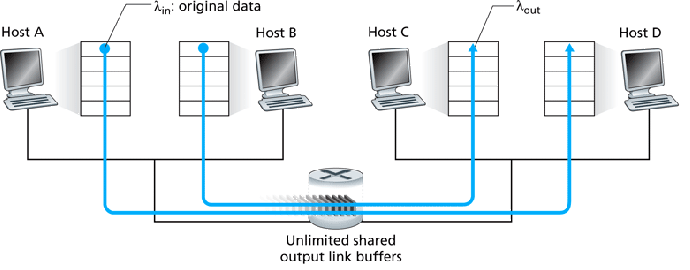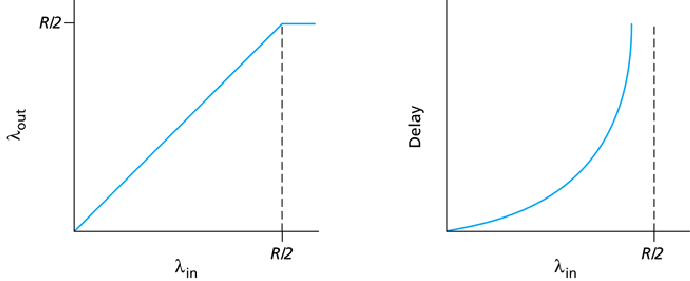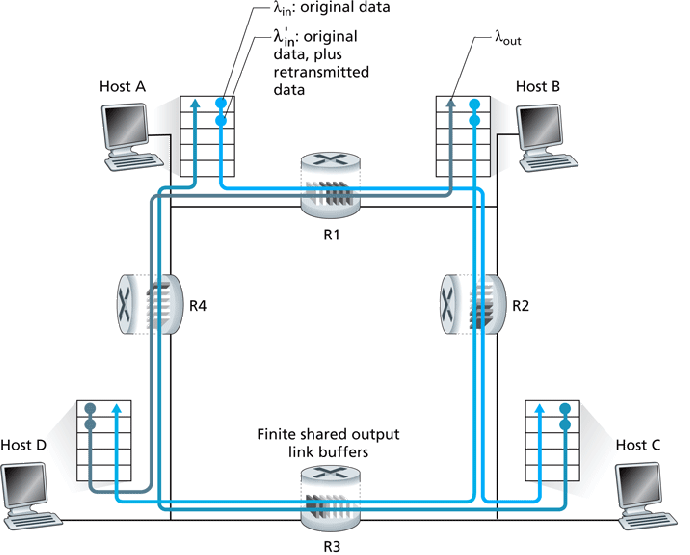
Tom Kelliher, CS 325
Mar. 30, 2011
Read 4.1-4.3.
TCP Reliability.
Network layer introduction.

Assume the senders equally share the available bandwidth.


Due to retransmits,
![]() .
.

The graph on the left assumes the sender is omniscient and knows when the router has free buffers and only transmits segments then, avoiding dropped segments. -- unrealistic.
The middle graph shows what could happen if the sender retransmits only segments known to be lost -- again, unrealistic. Here, we assume 17% of segments are retransmits.
The graph on the right shows this realistic scenario, assuming each segment is retransmitted once.

Worst case, B-D traffic could completely lock-out A-C traffic beyond the
point at which
![]() saturates the routers' transmit
capacity:
saturates the routers' transmit
capacity:
![\includegraphics[width=3.5in]{Figures/fig03_48.eps}](mar30img13.png)
![\includegraphics[width=4in]{Figures/fig03_49.eps}](mar30img14.png)
Two approaches:
Third idea for TCP: increased RTTs mean congestion is beginning to become a problem.
Receiver responsible for getting the indication back to the sender.
We therefore have
![]() .
.
So, RcvWindow, controlled by receiver, can be used to throttle sender rate.
We then have:
TCP congestion control algorithm:
Not as bad as a timeout.
Increase rate is controlled by RTT -- a lower RTT results in faster CongWindow increase rate.
Often implemented by increasing CongWindow by
![]() for each new ACK.
for each new ACK.
![\includegraphics[width=5in]{Figures/fig03_51.eps}](mar30img21.png)
Exponential increase in CongWindow during SS phase:
![\includegraphics[width=4in]{Figures/fig03_52.eps}](mar30img22.png)
![\includegraphics[width=4in]{Figures/fig03_53.eps}](mar30img23.png)
TCP Reno = current algorithm. Is decrease from timeout or fast retransmit?
| State | Event | Sender Action | Comment |
| Slow Start (SS) | New ACK received | CongWin = CongWin + MSS. if
(CongWin |
CongWin doubles every RTT. |
| Congestion Avoidance (CA) | New ACK received | CongWin = CongWin + MSS(MSS/CongWin) | CongWin increases by 1 MSS every RTT. |
| SS or CA | Triple Dup ACK | Threshold = CongWin/2. CongWin = Threshold. set state to CA. | Fast recover; multiplicative decrease. |
| SS or CA | Timeout | Threshold = CongWin/2. CongWin = 1 MSS. Set state to SS. | |
| SS or CA | Duplicate ACK received | Increment duplicate ACK count for segment |
![\includegraphics[width=4in]{Figures/fig03_54.eps}](mar30img25.png)
Suppose, initially, connection 1 has a higher throughput (CongWindow) than connection 2:
![\includegraphics[width=4in]{Figures/fig03_55.eps}](mar30img26.png)
This shows what happens during 3DupACK events -- multiplicative decrease. Eventually, we converge to equal throughput.
On timeout, both connections will end up with a CongWindow of 1 MSS.